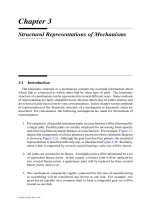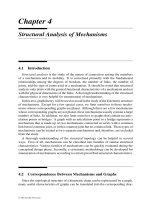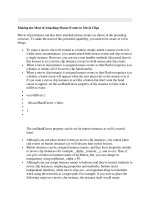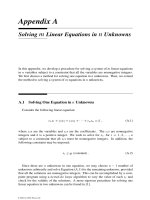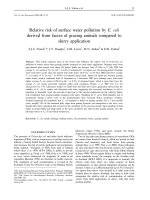Physiological adaptability of three mangrove species to salt stress ppt
Bạn đang xem bản rút gọn của tài liệu. Xem và tải ngay bản đầy đủ của tài liệu tại đây (261.66 KB, 6 trang )
ACTA ECOLOGICA SINICA
Volume 27, Issue 6, June 2007
Online English edition of the Chinese language journal
Cite this article as: Acta Ecologica Sinica, 2007, 27(6), 2208−2214.
Received date: 2006-12-04; Accepted date: 2007-03-16
*Corresponding author. E-mail:
Copyright © 2007, Ecological Society of China. Published by Elsevier BV. All rights reserved.
RESEARCH PAPER
Physiological adaptability of three mangrove species to salt
stress
Liao Yan, Chen Guizhu
*
School of Environmental Science and Engineering, Sun Yat-sen University, Guangzhou 510275, China
Abstract: The impact of salinity on three arboreal mangrove plants, Sonneratia apetala (Sa), S. caseolaris (Sc) and Rhizophora
stylosa (Rs), was studied. The three mangrove species were treated with different salinity levels over a three-month period. The re-
sponse and adaptation of these three mangrove species to salinity were shown to be different. Net photosynthesis rate, stomata con-
ductance and transpiration rate of leaves decreased and soluble sugar content in leaves increased, with salt concentration in all three
mangrove species. The malondial dehyde (MDA) content in stems and leaves of Sa and Sc somewhat decreased when the salinity
was lower than 10, but rapidly increased with increasing salt concentration. The MDA content in stems and leaves of Rs increased
only when salinity was greater than 40. No changes were observed in the MDA content of roots in the three mangrove species. The
adaptabilities of Sa and Sc to salt tolerance were limited. The more salt tolerant the mangrove Rs, the more likely the free oxygen
radicals were eliminated through the increase in activity of superoxide dismutase (SOD). Results of this experiment identified salin-
ity levels best suited for the growth and metabolism of the species, which provides information necessary for maintaining mangrove
forestation along the South China coast.
Key Words: Sonneratia apetala; S. caseolaris; Rhizophora stylosa; salt stress; net photosynthesis rate; stomata conductance; tran-
spiration rate; soluble sugar; membrane peroxidation; SOD
Mangroves, a kind of xylophyte, form unique communities
in tropical and subtropical regions and tidal lowlands. Ecol-
ogically, they play an essential role in protecting adjacent land
from wave and storm erosion
[1,2]
and providing habitat and
food for fish, prawns, crabs, shellfish and birds. They can also
filter surface water from inland, and reduce pollutants in off-
shore waters
[3]
.
Mangrove plants generally grow in a special environment
with certain salinity and consequently have their special adap-
tation system, different from land plants and freshwater plants.
It is generally thought that mangrove plants grow in certain
salinity conditions and the adaptation of different species to
salinity is different
[4,5]
. Above or below certain salinity level,
their growth will be inhibited and even death can occur. Under
salt stress, that is, beyond appropriate salinity, either low or
high, the flexibilities and physiological reactions of different
mangrove species are dissimilar. The major physiological
characteristics, such as photosynthesis, protein synthesis and
energy metabolism, are also more or less affected
[6]
.
Sonneratia apetala (Sa), S. caseolaris (Sc) and Rhizophora
stylosa (Rs) are three dominant mangrove species on the
coastland of South China. Of them, Sa and Sc were introduced
from Bengal, and have become the most important species in
afforestation along coastal areas. In this article, research on
the physiological reaction of the three mangrove species with
various treatments of salinity has been carried out and the
relationship between different physiological reactions is ex-
plored, which helps to reveal the effect of salinity changes on
the three species and provides a reference index for the choice
of salt tolerant species.
1 Materials and methods
1.1 Materials
Seedlings of Sa, Sc and Rs were collected from the man-
grove nature reserve (19°51'N, 110°24'E), Dongzhai Gulf in
Hainan Island, China, at the end of January 2006, and all the
LIAO Yan et al. / Acta Ecologica Sinica, 2007, 27(6): 2208–2214
seedlings were one-year-old with similar size. Seventy-two
seedlings of each mangrove species were planted in plastic
pots with 60 kg clay and every pot contained nine seedlings.
They were irrigated daily for three months with six liters of
brine, whose salinity varied from 0 to 50, that is, 0, 5, 10, 15,
20, 30, 40 and 50. Water was emptied every night. Every sev-
eral days water was replenished to keep the salinity stable.
They were placed in natural light. Every 30 days, brine was
replaced by water with the same salinity. The apparatus (Orion
4 star) was used to analyze the water quality. The total time
period was 90 days.
1.2 Methods
Salt scale: use water to dissolve sea salt, and use WYY35T
salinometer to rectify salinity.
Net photosynthesis rate, stomata conductance and transpira-
tion rate were measured with the help of Li-6200 portable
photosynthesis apparatus (made in USA). The mature, stable
leaves were chosen as research objects and measured, with
temperature controlled between (20 ± 2)℃, light quantum flux
between 600–800 μmol/(m
2
·s), relative humidity between 60%
± 5%, and CO
2
density 3.6 × 10
4
.
The total soluble sugar content was measured using the
anthrone colorimetry
[7]
. The extracts were gained by referring
to Lin’s method
[8]
.
Protein content was measured according to Bradford’s
method
[9]
. Coomassie brilliant blue G250 dye and colorimetry
were used at the wavelength of 595 nm. Bovine serum albu-
min (BSA) was used as standard protein. Protein content was
expressed by mg/g fresh weight.
The upper lucid extracts served as the materials for meas-
uring the activity of superoxide dismutase (SOD) and the
content of malondial dehyde (MDA). The above operations
were carried out in a temperature between 0–4℃. Heath’s
methods were used as reference in the measurement of mem-
brane peroxidation function, and MDA was used as index of
membrane peroxidation function
[10]
. MDA content was calcu-
lated according to the MDA mole extinction coefficient △ε
(532–600 nm) = 155 μmol
–1
·cm
–1
and was expressed by mmol/
mg protein. The method which Beauchamp and Fridovich
[11]
established was used to measure the activities of SOD. By
suppressing reducing agent NBT, 50% was taken as an en-
zyme activity unit, and the enzyme activity was expressed by
unit/mg protein.
The measurements of all indices were repeated at least
thrice.
2 Results and analysis
2.1 Effects of salinity on leaf net photosynthesis rate,
stomata conductance and transpiration rate of Sa, Sc and
Rs
The indices of leaf net photosynthesis rate, stomata con-
ductance and transpiration rate of the three mangrove species
were measured at the same time (9 a.m., April 27, 2006). It
was found that photosynthesis was inhibited by high salinity.
Net photosynthesis rate and stomata conductance of Sa and Sc
decreased as salinity in the culture medium rose from 0 to 40
(Figs. 1 and 2). When salinity was above 15, the decreasing
tendency was obvious. Net photosynthesis rate of Rs increased
appreciably in the beginning (< 20) and decreased subse-
quently (> 20), but the changes tended to be minor. Stomata
conductance of Rs increased to 10, the highest level in salinity,
but the overall changes were not obvious. In high salinity, in
all three mangrove species, the metabolic flow with the out-
side slowed down, which was shown by the fact that net pho-
tosynthesis rate and stomata conductance decreased and these
plants completed metabolism by accumulating internal CO
2.
According to the changing tendency, in low salinity (< 15), the
net photosynthesis rate and stomata conductance of Sa and Sc
were relatively stable, which showed the adaptation of the two
species to low salinity. Net photosynthesis rate and stomata
conductance of Rs rose to the highest level in salinity, 20 and
15, or even higher salinity, they did not change visibly, which
was possibly related to the salt rejection in the roots of Rs, that
is, salt did not get to the leaves and consequently had less ef-
fect on Rs than on Sa and Sc.
Transpiration rate of Sa and Sc decreased with an increase
in salinity. Transpiration rate of Sc decreased sharply in low
salinity, but transpiration rate of Rs kept steady (Fig. 3). This
tendency was similar to that of the effects of salinity on sto-
Fig. 1 Effect of salinity on leaf net photosynthesis rate of Sa, Sc
and Rs
Fig. 2 Effect of salinity on leaf stomata conductance of Sa, Sc and
Rs
LIAO Yan et al. / Acta Ecologica Sinica, 2007, 27(6): 2208–2214
mata conductance (Fig. 2), which indicated that the decrease
of stomata conductance affected transpiration rate to some
extent, and enhanced the mangrove’s function of conserving
water in high salinity. Rs stability of transpiration rate proved
that metabolism was kept at a stable level.
2.2 Effects of salinity on total soluble sugar content in
leaves of Sa, Sc and Rs
Through cultivating three mangrove species with various
salt concentrations for three months, it was discovered that
total soluble sugar content in leaves of Sa, Sc and Rs all tended
to rise with increase in salinity. Total soluble sugar content in
leaves of Sa and Sc increased by a larger margin in high salin-
ity (> 30) than in low salinity (< 30). For Rs, total soluble
sugar content increased steadily (Fig. 4).
This result indicated that water scarcity stress enhanced as
salinity increased (from 0 to 40). To control the balance of
ions in the vacuole, the cells accumulated a type of low, com-
patible molecular compound, which took the place of water as
a solvent in biochemical reactions and protected cell structure
and water circulation
[12]
. As was shown in the experiment,
with the salinity above 30, soluble sugar content in leaves of
Sa and Sc increased, thus improving the permeability and
maintaining a balance of water metabolism
[13]
. However, solu-
ble sugar content in leaves of Rs was always at a low level,
which could have resulted from the salt rejection of Rs, that is,
it was difficult for the salt to get to the leaves, and the total
soluble sugar content did not change a lot. Or it could be ex-
plained as the accumulation of other compatible solutes, such
as praline
[14,15]
, glycine
[16,17]
and polyol
[18,19]
.
2.3 Effects of salinity on membrane peroxidation and
activities of SOD of roots, stems and leaves of Sa, Sc and
Rs
It was discovered that membrane peroxidation was affected
remarkably by salt stress in leaves and stems of Sa, Sc and Rs.
MDA content in leaves and stems of Sa and Sc decreased
slightly in low salinity (< 10) and then increased rapidly (Figs.
5 and 7), which was reverse to the activities of SOD (Figs. 6
Fig. 3 Effect of salinity on leaf transpiration rate of Sa, Sc and Rs
Fig. 4 Effect of salinity on soluble sugar content in leaves of Sa,
Sc and Rs
Fig. 5 Effect of salinity on leaf membrance peroxidation in leaves,
stems and roots of Sa
Fig. 6 Effect of salinity on SOD activity in leaves, stems and roots
of Sa
Fig. 7 Effect of salinity on leaf membrance peroxidation in leaves,
stems and roots of Sc
LIAO Yan et al. / Acta Ecologica Sinica, 2007, 27(6): 2208–2214
and 8). It was thus evident that, although membrane peroxida-
tion was affected remarkably in leaves and stems of Sa, Sc, no
more SOD was generated, which might be related to the types
of the plants or possibly to the fact that Sa and Sc made other
peroxisome or catalase protect membrane peroxidation from
being destroyed with the help of active oxygen free radicals.
Dissimilar to the changing tendency of salinity effects on
MDA content in leaves and stems of Sa and Sc, MDA content
of Rs decreased in low salinity (< 40) and increased only
when salinity was higher than 30 (Fig. 9). It was because high
salinity affected the metabolism system balance of active
oxygen, increased the content of active oxygen, and conse-
quently the membrane structure was destroyed by the super-
oxide anion free radicals, and then the peroxide was produced,
for instance. For Rs, under high salinity stress, SOD was more
active (Fig. 10) and the changing tendency was reverse to that
of the salinity effect on the MDA content (pertinence coeffi-
cient R
2
= 0.893). It showed that Rs mainly depended on SOD
to remove the active oxygen free radicals and SOD activity in
leaves and steams directly affected the MDA content. When
salinity was above 40, the membrane protection system was
destroyed, the SOD activity decreased and the MDA content
increased.
Changes in MDA content and activities of SOD in roots of
three mangrove species showed that they were insensitive to
salinity. The reason is that the mangrove plant roots are sub-
mersed in seawater perennially and the roots don’t have
enough oxygen to absorb, and therefore mangrove plants have
developed a root metabolism system, which has adapted to the
special environment. This kind of root metabolism system has
possessed a special physiological adaptation mechanism, which
can be explained by the relatively small changes in the mem-
brane peroxidation of roots in high salinity.
To summarize, when salinity is higher than 40, the man-
grove species Rs can have some adaptations or endurance to
salt stress, the function of membrane protection system is im-
proved in the stems and leaves or almost kept at a high level in
the roots, and therefore, the damage that various free radicals
cause to membranes is kept at a small degree, which protects
the normal cell function and ensures the seedlings with a normal
growth. When the salinity becomes much higher, the function
of the membrane protection system decreases, various free
radicals gradually cause great damage to the membrane, and
membrane peroxidation becomes obvious. All this causes a
disturbance in the normal metabolism, a weakness in cell
function, and a decrease in adaptation and endurance to salin-
ity stress. It can be concluded that under salt stress, in seed-
lings of Rs, free radicals do cause damage to membrane,
namely, membrane peroxidation and protection resulted from
SOD or other systems influence each other. In comparison
with Rs, Sa and Sc have a little bad salt tolerance, and SOD
does not have strong protection ability for membrane.
3 Discussion
The physiological characteristics of the three mangrove
species were greatly affected with various salt treatments. Its
overall tendency was that changes in Sa and Sc were more
obvious than in Rs, which proved that Rs adaptability to high
salinity was much stronger. Sa and Sc could survive in high
salinity, but high salinity deeply influenced their growth and
metabolism.
In the field of phytophysiology, many studies have been
carried out on the effects of salinity on physiology of man-
Fig. 8 Effect of salinity on SOD activity in leaves, stem and roots
of Sc
Fig. 9 Effect of salinity on leaf membrance peroxidation in leaves,
stems and roots of Rs
Fig. 10 Effect of salinity on SOD activity in leaves, stems and
roots of Rs
LIAO Yan et al. / Acta Ecologica Sinica, 2007, 27(6): 2208–2214
grove species, and also on effects of salinity on stomata con-
ductance and transpiration. Kotmire
[20]
and Nazaenko
[21]
found
that high salinity inhibited photosynthesis by closing the
stoma and partially suppressing RUBISCO’s activity. High
temperature, intense light, drought and high salinity proved to
be able to stimulate genes related to heat shock proteins in
plants and in mangrove plants, too. Several studies showed
that salt stress could weaken photosynthesis of mangrove
plants
[22–24]
. There were also studies that with salt concentra-
tion, photosynthesis is not weakened and even in low salinity,
photosynthesis is enhanced
[25,26]
. All the difference is mainly
related to the species, and the salt stress exerts different effects
on different species.
The reasons for the decrease of photosynthesis rate are
mainly as follows: first, dehydration in cell membrane de-
creases permeability to CO
2;
second, it is because of salt toxic-
ity; third, closure of the stoma causes the decrease of CO
2;
fourth, salt concentration quickens senescence; fifth, changes
in cell structure cause changes in enzyme activity
[27]
. Decrease
in the photosynthesis rate also results from the decrease of
stomata conductance, which causes the lack of CO
2,
necessary
for carboxyl reaction
[28]
. Closure of the stoma reduces water
evaporation, affects photosynthesis of the chloroplast and im-
pacts energy transformation system, thereby changing the
activity of the chloroplast. To what extent the closure of the
stoma affects the photosynthesis rate depends on the partial
pressure of CO
2
in the lamina. However a study reported that
under salt stress, photosynthesis decreases because stoma
opening is not being inhibited
[27]
. Because of enhancing the
transfer resistance to CO
2
and decreasing the efficiency for
RUBISCO, stoma opening is not affected. According to the
feedback of other salt-induced reactions, inhibiting the me-
tabolism processes of some carbons can also decrease photo-
synthesis
[29]
.
Another mechanism that mangrove plants overcame under
high permeable pressure, in an environment with high salinity,
was accumulating a compatible solute. Popp and other re-
searchers
[30]
studied 23 types of mangrove plants and discov-
ered that pinitol and mannitol were the most common com-
patible solute. They also discovered proline in Xylocarpus
plants, methyl quaternary ammonium compounds in two kinds
of Avicennia plants, Acanthus ilicifolius and Heritiera lit-
toralis, and also in Hibiscus tiliaceus. As a compatible solute,
glycine was discovered in Avicennia marina
[31]
.
As is shown by experiment results in this article, when sa-
linity is higher than 30, total soluble sugar content in leaves of
Sa and Sc increases, thus improving the permeability and
maintaining a balance of water metabolism. However, total
soluble sugar content in leaves of Rs is always at a low level
and this could result from the salt rejection of Rs, so salt does
not have a lot of effect on total soluble sugar content. Other-
wise, it could be explained as the accumulation of other com-
patible solutes.
Active oxygen includes superoxide, hydrogen peroxide and
hydroxyl, which can be induced by extreme environment
stress, such as extreme temperature, herbicide, drought and
nutrient stress. Some higher plants resist active oxygen by
improving the activity of the antioxidizing enzyme. SOD
catalyzes the transformation of superoxide to hydrogen per-
oxide
[32,33]
, and then hydrogen peroxide is decomposed by the
hydrogen peroxide enzyme and peroxide enzyme
[34]
. However,
there are very few reports about effects of salt stress on the
active oxygen mechanism. Superoxide toxicology holds that
on the one hand, active oxygen free radicals can cause oxida-
tion of membrane and damage the membrane structure and
normal cell physiology, but on the other hand, a membrane
protection system also exists and slows the damage
[35]
. This
membrane protection system is in fact an anti-oxidation sys-
tem, which generates different antioxidizing enzymes includ-
ing the important SOD. SOD can effectively eliminate the
active oxygen free radicals and prevent the membrane from
damaging by oxidation
[36]
.
The research of Zhao
[37]
indicated that MDA content of the
plant increased with the increase of salt concentration,
whereas the activity of SOD and ATP enzyme reduced with
the increase of salt concentration, which proved the existence
of a damage mechanism of free radicals to terraneous plants.
This research showed that the activities of SOD were in-
versely correlated to the MDA content in organs of salt toler-
ant mangrove plants Sa, Sc and Rs (Figs. 5–10). The overall
tendency in Sa and Sc was that membrane peroxidation in-
creased with the increase of salt concentration and the activi-
ties of SOD decreased at the same time. In Rs, when salinity
was above 40, the damage of membrane peroxidation became
obvious.
Acknowledgements
The project was financially supported by UNEP GEF “Re-
versing Environmental degradation trends in the South China
Sea and Gulf of Thailand” Program (UNEP/GEF/SCS/Chi/
MoU 2d).
References
[ 1 ] Banijbatana D, Mangrove forest in Thailand. Proceedings of the
9th Pacific Science Congress, Bangkok, 1957. 22–34.
[ 2 ]
Savage, T. Florida mangroves as shoreline stabilizers. Florida
Department of Natural Research. Prof. Paper, 1972, No. 19, 46
–47.
[ 3 ] Dubinsky Z, Stambler N. Eutrophication, marine pollution and
coral reefs. Global Change Biol, 1996, 2, 511–526.
[ 4 ]
Conner V J. Growth of grey mangrove (Avicennia marina) in nu-
trient culture. Biotropica, 1969, 1(2): 37–40.
[ 5 ]
Downton W J S. Growth and osmotic relations of the mangrove
LIAO Yan et al. / Acta Ecologica Sinica, 2007, 27(6): 2208–2214
Avicennia marina, as influenced by salinity. Aust. J. Plant
Physiol, 1982, 9: 519–528.
[ 6 ] Zhu J K. Salt and drought stress signal transduction in plants.
Ann Rev Plant Biol, 2002, 53: 247–273.
[ 7 ] Zhang Zhiliang. instruction of experiment to Plant-physiology
(the 3
rd
edition). Beijing: Higher Education Press, 2003. 127–
128.
[ 8 ]
Lin Z F, Li S S. The relationship of consenescence of paddy rice
leaves and hyperoxide dismutase activeness and the lipin per-
oxidation function. Chinese Plant Journal, 1984, 26(8): 605–
619.
[ 9 ] Bradford M M. A rapid and sensitive method for the quantita-
tion of microgram quantities of protein utilizing the principle
of protein-dye binding. Anal. Biochem, 1976, 72: 248–254.
[10] Heath R L, Packer L. Photoperoxidation in isolated chloro-
plasts, Kinetics and stoichemistry of fatty acid peroxidation.
Arch. Biochem Biophys, 1968, 125: 189–198.
[11] Beauchamp C, Fridovich I. Superoxide dismutase, Improved
assays and assasy applicable to acrylamidegels. Anal. Biochem,
1971, 44: 276–287.
[12] Zhifang G, Loescher W H, Expression of a celery mannose 6-
phosphate reductase in Arabidopsis thaliana enhances salt tol-
erance and induces biosynthesis of both mannitol and a gluco-
syl-mannitol dimmer. Plant Cell Environ, 2003, 26: 275– 283.
[13] Zheng W J, Lin P. The physiological characteristics of salt
tolerance for Kandelia candel seedlings. Journal of Xiamen
University (natural science), 1993, 32(4): 113–118.
[14] Zheng Q S, Liu L, Liu Y L, et al. Effects of Salt and Water
Stresses on Osmotic Adjustment and Osmotica Accumulation
in Aloe vera Seedlings. Acta Photophysiologica Sinica, 2003,
29(6): 585–588.
[15] Singh S K, Sharma H C, Goswami A M, Datta S P, Singh S P,
In vitro growth and leaf composition of grapevine cultivars as
affected by sodium chloride. Biol. Plant, 2000, 43: 283 –286.
[16] Macnae W. A general account of the fauna and flora of man-
grove swamps and forest in the Indo-West-Pacific region. Ad-
vances in Marine Biology, 1968, 6: 74–270.
[17] Wang Y, Nil N. Changes in chlorophyll, ribulose biphosphate
carboxylase–oxygenase, glycine betaine content, photosynthe-
sis and transpiration in Amaranthus tricolor leaves during salt
stress. Hortic. Sci. Biotechnol, 2000, 75: 623–627.
[18] Bohnert H J, Nelson D E, Jensen R G. Adaptations to envi-
ronmental stresses. Plant Cell, 1995, 7: 1099–1111.
[19] Zhang H Y, Fan Z F. Comparative Study on the Content of
Inorganic and Organic Solutes in Ten Salt tolerant Plants in
Yuncheng Saltlake. Acta Ecologica Sinica, 2002, 22(3): 352–
358.
[20] Kotmire S Y, Bhosale L J. Photosynthesis in Avicennia and
Thespesia. Indian Bot. Reporter, 1985, 4: 46–49.
[21] Nazaenko L V. Effect of sodium chloride on ribulosebiphos-
phate carboxylase of Euglena cells. Fiziologiya Rastenii (Mos-
cow), 1992, 39: 748–752.
[22] Morimoto R I. Heat shock: the role of transient inducible re-
sponses in cell damage, transformation and differentiation.
Cancer Cells, 1991, 3: 295–301.
[23] Peng C L, Lin Z F, Lin G Z, et al. Effect of human disturbance
on antioxidative ability in leaves of subtropical forest woody-
plants. Acta Ecologica Sinica, 1998, 18(1): 101–106.
[24] Lichtenthaler H K. Vegetation stress: an introduction to the
stress concept in plants. J. Plant. Physiol., 1996, 148: 4–14.
[25] Rajesh A, Arumugam R, Venkatesalu V. Growth and photo-
synthetic characterics of Ceriops roxburghiana under NaCl
stress. Photosynthetica, 1998, 35: 285–287.
[26] Kurban H, Saneoka H, Nehira K, Adilla R, Premachandra, G S,
Fujita K. Effect of salinity on growth, photosynthesis and min-
eral composition in leguminous plant Alhagi pseudoalhagi
(Bieb.). Soil Sci. Plant Nutr., 1999, 45: 851–862.
[27] Iyengar E R R, Reddy M P. Photosynthesis in highly salt tol-
erant plants. In: Pesserkali, M. Ed., Handbook of photosynthe-
sis. USA: Marshal Dekar, Baten Rose, 1996. 897–909.
[28] Brugnoli E, Bjorkman O. Growth of cotton under continuous
salinity stress: influence on allocation pattern, stomatal and
nonstomatal components of photosynthesis and dissipation of
excess light energy. Planta, 1992, 187: 335–347.
[29] Greenway H, Munns R. Mechanisms of salt tolerance in non-
halophytes. Annu. Rev. Plant Physiol, 1980, 31: 149–190.
[30] Popp M, Larther F, Weigel P. Osmotic adaptation in Australian
mangroves. Vegetatio, 1985, 61: 247–254.
[31] Ashihara H, Adachi K, Otawa M, Yasumoto E, Fukushima Y,
Kato M, Sano H, Sasamoto H, Baba S. Compatible solutes and
inorganic ions in the mangrove plant Avicennia marina and their
effects on the activities of enzymes. Z. Naturforsh, 1997, 52:
433–440.
[32] He X L, Zhao L L, Li Y P. Effects of AM fungi on the growth
and protective enzymes of cotton under NaCl stress. Acta
Ecologica Sinica, 2005, 25(1): 188–193.
[33] Ye Y, Lu C Y, Hu H Y, Tam Nora-FongYee. Comparisons of
tolerances to salt stress among three salt-secreting mangrove
species. Acta Ecologica Sinica, 2004, 24(11): 2444–2450.
[34] Salin M L. Chloroplasts and mitochondrial mechanisms for
protection against oxygen toxicity. Free Rad. Res. Commun.,
1991, 12(13): 851–858.
[35] Fridovich I. Free radical in biology. New York: Academic
Press, 1976. 239.
[36] Li G Q, An S Q, Zhang J L, et al. Impact of salt stress on per-
oxidase activity in Populus deltoides cambium and its conse-
quence. Chinese Journal of Applied Ecology, 2003, 14(6): 871
–874.
[37] Zhao K F, Li M L. The physiology foundation of the mem-
brane penetrability increases with salt tolerance. The proceed-
ings of the sixth conference of vegetable academic committee
in China, 1993. 345.
